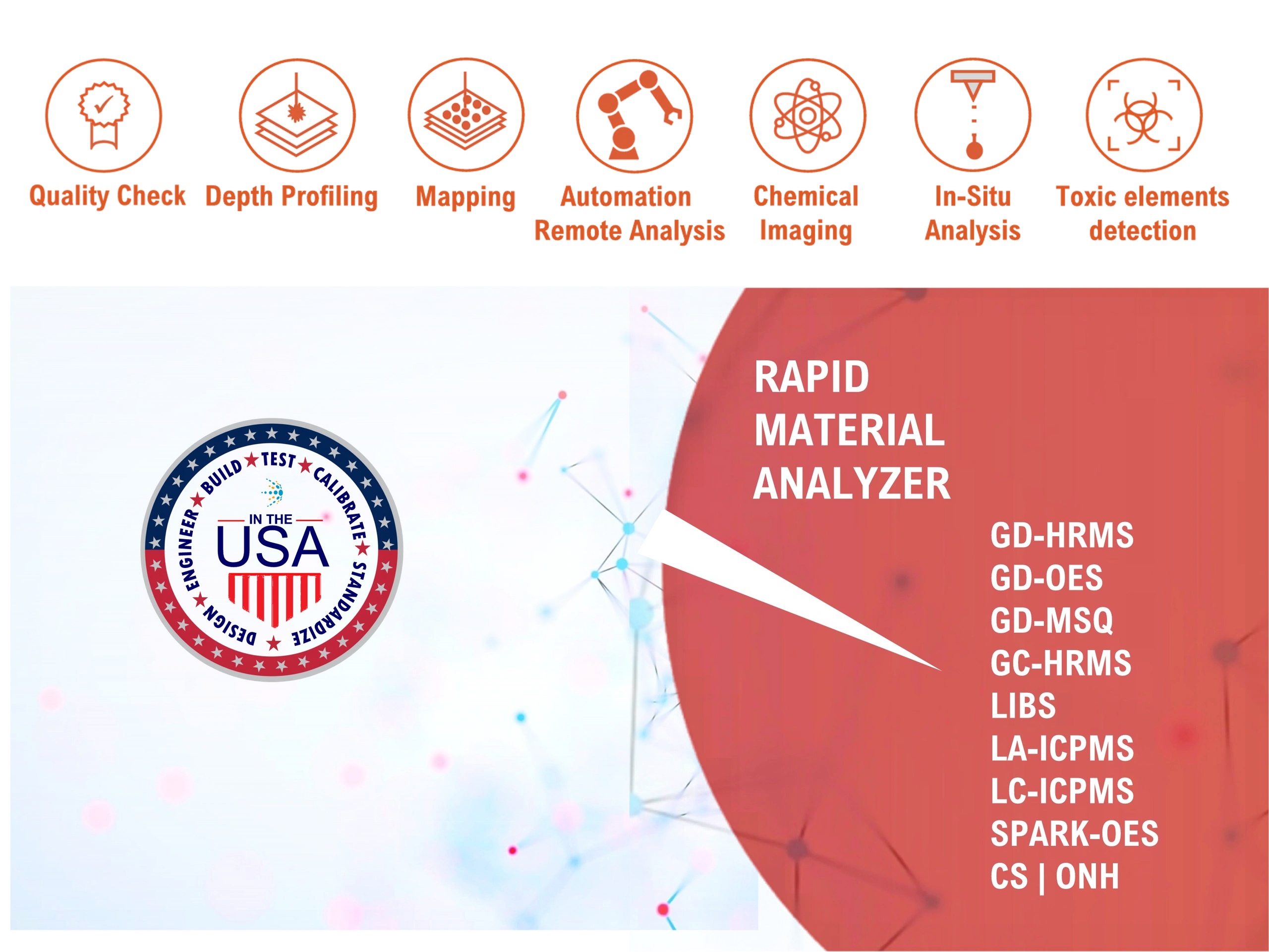Glow Discharge (GD) Analyzer for layers, thin film, substrates start < $99K
Spectrometric analysis - Composition, Depth Profiling, Mapping, remote analysis etc on conductive and non conductive solids
Spectrometric analysis - Composition, Depth Profiling, Mapping, remote analysis etc on conductive and non conductive solids
Glow Discharge Mass Spectrometer (GD-MS) is an advanced analyzer for the qualitative and quantitative analysis of chemical elements at a wide range of concentrations, down to the parts per trillion (ppt) level and the purity to 99.99999 (7N) It is a specialized form of mass spectrometry that utilizes a glow discharge plasma to ionize the sample material.
In GD-MS, the sample serves as the cathode within an Argon glow discharge plasma chamber. The plasma is ignited, leading to the sputtering (ejection) of material from the sample. This material is then atomized and ionized in the plasma. The resulting ions are extracted and accelerated into a double-focused magnetic sector field, where they are separated based on their mass-to-charge ratio (m/z). This ratio is unique to each element, enabling precise identification and quantification.
A significant advantage of GD-MS is that it allows for the direct measurement of samples with minimal preparation, making it a time-efficient and straightforward method.
GD-MS is particularly beneficial in a variety of applications, including materials science, environmental monitoring, and trace element analysis, due to its ability to analyze solid including powder samples, conductive and nonconductive with high sensitivity and precision.
Glow Discharge Mass Spectrometer (GD-MSQ or GD-QMS) is an advanced analyzer for the qualitative and quantitative analysis of chemical elements at a wide range of concentrations, down to the parts per billion (ppb) level. It is a specialized form of mass spectrometry that utilizes a glow discharge plasma to ionize the sample material.
In GD-MS, the sample serves as the cathode within an Argon glow discharge plasma chamber. The plasma is ignited, leading to the sputtering (ejection) of material from the sample. This material is then atomized and ionized in the plasma. The resulting ions are extracted and accelerated into a quadrupole mass analyzer, where they are separated based on their mass-to-charge ratio (m/z). This ratio is unique to each element, enabling precise identification and quantification.
A significant advantage of GD-MS is that it allows for the direct measurement of samples with minimal preparation, making it a time-efficient and straightforward method.
GD-MS is particularly beneficial in a variety of applications, including materials science, environmental monitoring, and trace element analysis, due to its ability to analyze solid including powder samples, conductive and nonconductive with high sensitivity and precision.
Glow Discharge Optical Emission Spectrometer (GDOES) with Direct Current (DC) is a powerful analytical technique used for the elemental analysis of materials, particularly for solid samples. It is a variant of Glow Discharge Optical Emission Spectroscopy (GDOES) that utilizes a DC glow discharge plasma for the excitation and ionization of the sample.
Advantages of GD-OES:
Glow Discharge Optical Emission Spectrometer (GDOES) with Radio Frequency (RF) is a variation of the GDOES technique that utilizes radio frequency (RF) power to generate the glow discharge plasma, instead of direct current (DC) power. This approach offers distinct advantages in terms of ionization and analysis capabilities, especially for materials that may not be well-suited for DC glow discharge, such as non-conductive or insulating materials.
Glow Discharge Optical Emission Spectrometer (GDOES) with RF & DC refers to a system that can operate using either Radio Frequency (RF) or Direct Current (DC) glow discharge to generate the plasma for elemental analysis. Each mode (RF and DC) has its own advantages and applications, and combining both options in a single system allows for greater versatility in analyzing a wide range of materials, including both conductive and non-conductive samples.
In Glow Discharge Optical Emission Spectrometer (GDOES), two types of detectors—Photomultiplier Tubes (PMTs) and Charge-Coupled Devices (CCDs)—are commonly used to measure the optical emissions from the plasma. Both PMT and CCD are essential components in GDOES systems, as they allow the system to capture the light emitted by excited atoms and ions within the plasma, which is then used for elemental analysis. Each detector has its own advantages, depending on the specific needs of the analysis, such as sensitivity, spectral range, and the type of sample being analyzed.
Glow Discharge Optical Emission Spectrometer (GDOES) with a Photomultiplier Tube (PMT) is an excellent combination for trace element analysis, offering high sensitivity and precision for detecting elements at low concentrations. The use of PMTs in GDOES systems is particularly advantageous when the goal is to identify and quantify trace elements in a sample, especially when sensitivity and selectivity are crucial.
In Glow Discharge Optical Emission Spectrometer (GDOES), the incorporation of linear detectors, such as CMOS (Complementary Metal-Oxide-Semiconductor) and CCD (Charge-Coupled Device), combined with high-resolution optics, significantly enhances the system's ability to detect and analyze elements with high sensitivity and accuracy. These detectors, along with high-resolution optical systems, enable detailed and precise measurement of elemental composition across a wide spectrum.
We love our customers, so feel free to visit during normal business hours.
Open today | 09:00 am – 05:00 pm |

We use cookies to analyze website traffic and optimize your website experience. By accepting our use of cookies, your data will be aggregated with all other user data.